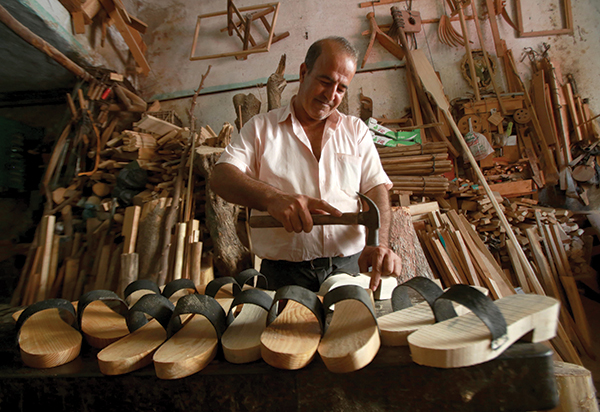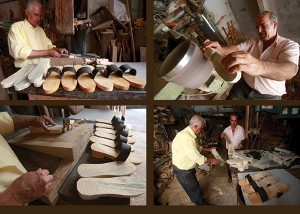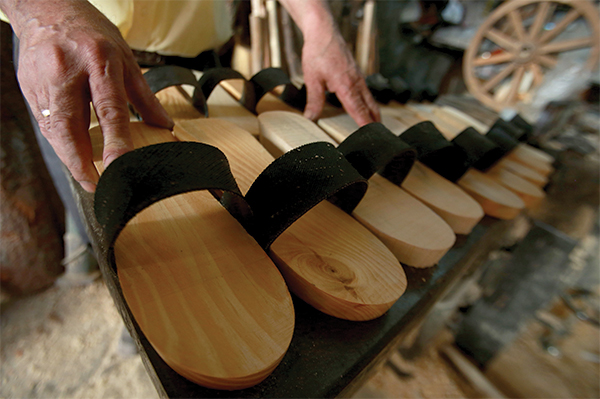The making of tarabeesh was not the only industry that flourished in Nablus, and that headdress was not the only item that disappeared with the modernization of dress, the change of governments, and the development of social structure. These days, there is yet another industry taking its last breath in Nablus and in other Arab cities such as Damascus and Cairo – the making of sabots, the old wooden shoe that borrowed its form from the depths of Arab history.
People interested in this craft can find their way through the dingy streets and spiral alleyways of the old city of Nablus, to the sole remaining maker of sabots, not just in the West Bank, but in all of historic Palestine. There, in the midst of piles of pinewood, they find a man sitting sternly in a shop that was built decades ago and that smells of glue and the mulch of dry wood. In that shop, passersby can observe the making of wooden sabots, a once-thriving craft in North Africa and across the Middle East that is now on the verge of extinction. Yet Waleed Khdair continues to carve beautiful shoes out of wood, to continue a legacy his family brought to Nablus, after being expelled from Al-Lud in 1948.
Nablus, the third-most-famous city for this specific craft (after Cairo and Damascus), has suffered from the slow demise of sabot making. These cities stopped identifying this craft as one of their major sources of income, so looking for sabots is a tremendous task; one has to travel from the farthest corners of Palestine into the deep alleyways of the old city of Nablus to find them.
Khdair, whose neighbors call him Abu Khalid, carries on the family legacy of making sabots, crafted by his father and grandfather before him. With the new plastic slippers and shoes in the market, the controversial making of sabots and their sales have diminished dramatically in major cities. Moreover, the massive leather and plastic invasion from Turkey and China has buried the existence of the sabot, which is only remembered in Arabic literature and plays from the 1970s.
In Nablus, a few sabots are made for use in the Turkish baths in the city. Standing in the shadow of piles of pinewood that is ready to become sabots, Khdair admits that although the sabot industry has been greatly diminished, it has not died. The life of the sabot is like many other industries that once constructed the Palestinian economy and have slowly disappeared due to social changes and modernity. Today, it would be fairly difficult to wear sabots around the house in new buildings because the noise from their heels would surely bother the neighbors.
Nevertheless, Khdair’s sabots are sold even beyond the borders of Nablus. Merchants sell them in multiple areas in historic Palestine. The Khdair family initially started the industry in Al-Lud, in the 1948 areas, but moved it with them to their new home in Nablus, in the same way that many other industries migrated. While carving a brand new sabot, Khdair boasts, “Here, you can get good quality sabots.” He adds a layer of plastic over the wood to protect it from wear and tear. He has made thousands of sabots during his life.

Like a lot of older industries and crafts, sabot making is passed down from one generation to the next. Khdair, who learned how to make sabots in specific sizes, is now teaching his 12-year-old son. “Ahmad makes very good sabots,” he says proudly.
Sabots are made according to Shami standards, aka Damascus, which is the most renowned city for this industry, although even there, very few people still practice the profession. Nablus is nicknamed little Damascus for many reasons, including similar architecture and trade. In Damascus, there is a sabot market right by the Umayyad Mosque. Since Nablus takes pride in its Turkish baths spread around the city just like in Damascus, bath owners buy original sabots for use by their clientele, who in turn sometimes go and purchase their own from Khdair.

The wooden sabot passes through many stages in the making, from the carving process to the plastic bordering. Pointing at the pile of wood, Khdair says that it will all be transformed into sabots. In addition, Khdair makes baby cribs that have technically ceased to exist in most markets. Khdair brings back the feel of traditional things, as did the Syrian actor, Duraid Laham, who brought to TV the sound of sabots on the floor in his renowned series Ghawar.
The sabot, which is disappearing even from memory, was once a prop in every story, one of which is the terrifying murder of Shajar Al-Dur with a sabot. In the same way as she was killed, the sabot has also been killed by the invasion of piles of cheap plastic shoes from China and other competitors!
» Jamil Dababat, a Palestinian journalist and writer, lives in Tubas in the northern West Bank, and has worked in the Palestinian News Agency (WAFA) for the past 15 years. He has covered stories in Palestine, North America, Africa, and Europe regarding Palestinian and international affairs. Dababat has won several national and international awards, and specializes in covering political, environmental, minority, and religious affairs.
Article photos courtesy of Ayman Noubani.



